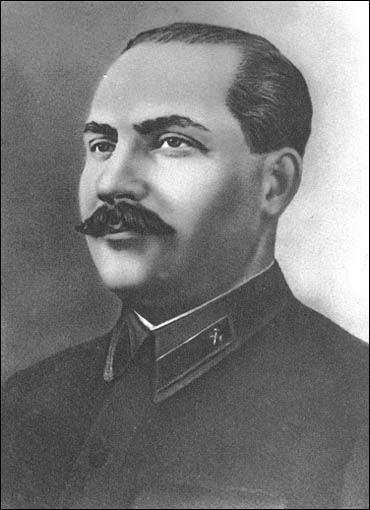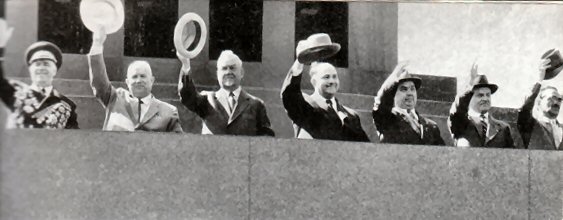<Back to Index>
- Military Historian Friedrich Adolf Julius von Bernhardi, 1849
- Painter Christian Rohlfs, 1849
- Leader of the Communist Party of Ukraine Lazar Moiseyevich Kaganovich, 1893
PAGE SPONSOR

Lazar Moiseyevich Kaganovich (Russian: Ла́зарь Моисе́евич Кагано́вич) (22 November [O.S. 10 November] 1893 – 25 July 1991) was a Soviet politician and administrator and a close associate of Joseph Stalin.
Kaganovich was born in 1893 to Jewish parents in the village of Kabany, Radomyshl uyezd, Kiev Governorate, Russian Empire (now named Dibrova, Poliske Raion, Kiev Oblast, Ukraine). Early in his political career, in 1915, Kaganovich became a Communist organizer at a shoe factory where he worked.
In 1911, he joined the Bolshevik party (following his older brother Mikhail Kaganovich who
was already a member). Later in 1915, Kaganovich was arrested and sent
back to Kabany. In March - April 1917, he was the Chairman of the Tanners
Union and the vice - chairman of the Yuzovka Soviet. In May 1917, he became the leader of the military organization of Bolsheviks in Saratov, and in August 1917, he became the leader of the Polessky Committee of the Bolshevik party in Belarus. During the October Revolution, he was the leader of the revolt in Homel.
In 1918, Kaganovich acted as Commissar of the propaganda department of the Red Army. From May 1918 to August 1919, he was the Chairman of the Ispolkom of the Nizhny Novgorod gubernia. In 1919 - 1920, he was leader of the Voronezh gubernia. From 1920 to 1922, he was in Turkmenistan, where he was one of the leaders of the Bolshevik struggle against local Muslim rebels (basmachi) and also led punitive expeditions against the local opposition.
In May 1922, Stalin became the General Secretary of the Communist Party and immediately transferred Kaganovich to his apparatus to head the Organizational Department or Orgburo of the Secretariat. This department was responsible for all assignments within the apparatus of the Communist Party. Working there, Kaganovich helped to place Stalin's supporters in key positions within the Communist Party bureaucracy. In this position, he was noted for his high work capacity and personal loyalty to Stalin. He publicly stated that he would execute absolutely any order from Stalin, which at that time was a novelty.
In 1924, Kaganovich became a member of the Central Committee. From 1925 to 1928, Kaganovich was the First Secretary of the Communist Party of the Ukrainian SSR. In Ukraine he was given the task of "korenizatsiya", the task of creating Ukrainian communist grassroots cadres. He was also given the task of implementing collectivization and the rigid policy of economic suppression of the kulaks (wealthier peasants) and his staunch opposition to the more moderate policy of Nikolai Bukharin who argued in favor of the "peaceful integration of kulaks into socialism." In 1928, due to numerous protests against Kaganovich's leadership, Stalin was forced to transfer Kaganovich from Ukraine to Moscow, where he returned to his role as a Secretary of the Central Committee of the Communist Party, a position he held until 1939. As Secretary, he supported Stalin in his struggle against the so-called Left and Right Oppositions within the Communist Party, in the hope that Stalin would become the sole leader of the country. In 1933 - 1934, he was the Chairman of the Commission for the Vetting of the Party Membership (Tsentralnaya komissiya po proverke partiynykh ryadov) and personally ensured that nobody connected with the anti-Stalin opposition would be permitted to remain a Communist Party member. In 1934, at the XVII Congress of the Communist Party, Kaganovich was the chairman of the Counting Committee. He falsified voting for positions in the Central Committee, removing 290 votes opposing the Stalin candidacy. His actions led to Stalin's being re-elected as the General Secretary instead of Sergey Kirov. By the rules, the candidate receiving fewer opposing votes should become the General Secretary. Before Kaganovich's falsification, Stalin received 292 opposing votes and Kirov only three. However, the "official" result (due to the interference of Kaganovich) was that Stalin ended up with just two opposing votes.
In 1930, Kaganovich became a member of the Soviet Politburo and the First Secretary of the Moscow Obkom of the Communist Party (1930 – 1935) and Moscow Gorkom of the Communist Party (1931 – 1934). He also supervised the implementation of many of Stalin's economic policies, including the collectivization of agriculture and rapid industrialization. In
the 1930s, Kaganovich organized and greatly contributed to the building
of the first Soviet underground rapid transport system, the Moscow Metro,
which was named after him until 1955. During this period, he also
oversaw the destruction of many of the city's oldest monuments,
including the Cathedral of Christ the Saviour. In 1932, he led the suppression of the workers' strike in Ivanovo - Voznesensk.
Kaganovich (together with Vyacheslav Molotov) took part in the All-Ukrainian Party Conference of 1930 and actively encouraged the policies of collectivization that according to many historians led to a catastrophic 1932 - 33 famine known to many Ukrainians (who especially suffered) as the Holodomor. He also personally oversaw grain confiscations during the same time periods. Similar policies also inflicted enormous suffering on the Soviet Central Asian republic of Kazakhstan, the Kuban region, Crimea, the lower Volga region, and other parts of the Soviet Union. As an emissary of the Central Committee of the Communist Party, Kaganovich traveled to Ukraine, the Central region of Russia, the Northern Caucasus, and Siberia demanding the acceleration of collectivization and repressions against the kulaks, who were generally used as scapegoats for the slow progress of collectivization, and their supporters. Attorney Rafael Lemkin in his work The Soviet genocide in Ukraine tried to bring the fact of Holodomor to the Nuremberg trials as a genocide of a totalitarian regime.
On January 13, 2010 the Kiev Court of Appeals posthumously found Kaganovich along with several other Soviet leaders guilty of genocide against Ukrainians during Holodomor catastrophic famine. Kaganovich and several other Soviet officials
were found guilty, however the case was immediately
closed by the paragraph 8 of Article 6 of the Criminal Procedural Code
of Ukraine. The
importance of the case is lying in its historical aspect that legally
explains the particularity of the already mentioned historical event. The Security Service of Ukraine has finished a pre-court investigation and transferred its materials to the Prosecutor General of Ukraine.
The materials consist of over 250 volumes of archive documents (from
within Ukraine as well as abroad), interviews with witnesses, and
expert analysis of several institutes of National Academies of Sciences. Oleksandr Medvedko, the Prosecutor General, confirmed that the material is a clear evidence of the genocide that was taking place in Ukraine.
From 1935 to 1937, Kaganovich worked as Narkom (minister) for the railways. Even before the start of the Great Purges, he organized the arrests of thousands of railway administrators and managers as supposed "saboteurs". From 1937 to 1939, Kaganovich served as Narkom for Heavy Industry. In 1939 – 1940, he served as Narkom for the Oil Industry. Each of his assignments was connected with arrests in order to improve discipline and compliance with Stalin's policies.
In all Party conferences of the later 1930s, he made speeches demanding increased efforts in the search for and persecution of "foreign spies" and "saboteurs". For his ruthlessness in the execution of Stalin's orders, he was given the nickname "Iron Lazar". During the period of Great Terror starting in 1936 Kaganovich's signature appears on 188 out of 357 documented execution lists.
One of many who perished during these years was Lazar's brother, Narkom of the Aviation Industry Mikhail Kaganovich. On January 10, 1940, Mikhail was demoted to director of the aviation plant "N24" in Kazan. In February 1941, during the 18th Conference of the Communist Party, Mikhail was warned that if the plant missed its deadlines he would be ejected from the Party. On June 1, 1941, Stalin mentioned to Lazar that he had heard that Mikhail was "associating with the right wing". Lazar reportedly did not speak in the defense of his brother to Stalin, but did notify him by telephone. The same day Mikhail committed suicide.
During the Great Patriotic War, Kaganovich held the position of the Commissar (Member of the Military Council) of the North Caucasian and Transcaucasian Fronts. In 1943 – 1944, he was again the Narkom for the railroads. In 1943, he was presented with the title of the Hero of Socialist Labor. From 1944 to 1947, Kaganovich was the Minister for Building Materials. In 1947, he became the First Secretary of the Ukrainian Communist Party. During 1948 to 1952, he served as the Chief of Gossnab, and from 1952 to 1957, as the First Vice-Premier of the Council of Ministries.
Kaganovich was, until 1957, a full member of the Politburo as well as the Presidium. He was also an early mentor of eventual First Secretary of the Communist Party Nikita Khrushchev, who first rose to prominence as Kaganovich's Moscow City
deputy in the 1930s. In 1947, when Khrushchev was stripped of the Party
leadership in Ukraine (he remained in the somewhat lesser "head of
government" position), Stalin dispatched Kaganovich to replace him
until Khrushshev was reinstated later that year.
Kaganovich was a rigid Stalinist, and though he remained a member of the Presidium, quickly lost influence after Stalin's death in March 1953. In 1957, along with fellow hard-line Stalinists Vyacheslav Molotov, Kliment Voroshilov, and Georgy Malenkov (the so called Anti-Party Group), he participated in an abortive party coup against his former protege Khrushchev, who had over the preceding two years become increasingly harsh in his criticism of Stalin. As a result of the unsuccessful coup, Kaganovich was forced to retire from the Presidium and the Central Committee, and was given the position of director of a small Ural potassium factory. In 1961, Kaganovich was completely expelled from the party and became a pensioner living in Moscow. His grandchildren reported that following his dismissal from the Central Committee, Kaganovich (who had a reputation for his temperamental and allegedly violent nature) never again shouted and became a devoted grandfather.
Kaganovich survived to the age of 97, dying just before the events that led to the final unravelling of the Soviet Union in 1991. He is buried in the famed Novodevichy Cemetery in Moscow.
In 1987, American journalist Stuart Kahan published a book entitled The Wolf of the Kremlin: The First Biography of L.M. Kaganovich, the Soviet Union's Architect of Fear. In the book, Kahan made a series of claims about Kaganovich's working relationship with Joseph Stalin and his activities during the Ukrainian famine,
and claimed to be the long lost nephew of Kaganovich. He also claimed
to have interviewed Kaganovich personally and stated that Kaganovich
admitted to being partially responsible for the death of Stalin in 1953
(supposedly via poisoning). A number of other unusual claims were made
as well, including that Stalin was married to Kaganovich's sister in
the last year of his life and that Kaganovich (a Jew) was the architect
of anti-Jewish pogroms. After The Wolf of the Kremlin was translated into the Russian language and a chapter from it printed in the Nedelya (Week) newspaper in 1991, remaining members of Kaganovich's family penned the Statement of the Kaganovich Familyin
response. The statement disputed all of Kahan's claims and provided
evidence that brought into question all of Kahan's factual assertions.
Additionally, Kaganovich's own memoirs, which were published in 2001,
largely contradict the statements in Kahan's book.
In 1944, the newly launched light cruiser of the project 26-bis was named after Lazar Kaganovich. It entered the Soviet Pacific Fleet in
December 1944. Kaganovich seems to have been responsible for the "eggs
and omelette" metaphor commonly attributed to Stalin himself. According to Time magazine and some newspapers, Lazar Kaganovich's son Mikhail (named after Lazar's late brother) married Svetlana Dzhugashvili, daughter of Joseph Stalin on July 3, 1951. Svetlana in her memoirs denies even the existence of such a son.
